Like many novice guitar builders I was inclined to overbuild my early guitars, the mortal fear of them imploding tending to override any suspicion that I was robbing them of their full tonal potential. It's been difficult to leave that mindset behind me, but with a conscious effort to "lighten up", and with the wisdom of more experienced luthiers in mind, I'm venturing further from my previous comfort zone with each guitar in an effort to increase their responsiveness. To that end, I've significantly reduced the mass of my soundboard braces, ever mindful of the delicate balance necessary between lightness and strength. Ironically, it's because of advice from those same sources that I'm inclined to leave the soundboard itself a little thicker than I may once have done.
John Mayes' "Advanced Voicing" DVD provided me with a way forward where carving the soundboard braces is concerned. Without a doubt, watching John shave and shape the soundboard braces then tap on the top to assess the changes he'd brought about has given me a much better insight into the process than I'd been able to gain through simply reading about other luthiers' methods in that regard. As John clearly demonstrates, judicious removal of small amounts of mass from one or more braces can make a big difference to the responsiveness of the soundboard. It's still a somewhat mysterious and inexact science for me, but recent results suggest that I'm heading in the right direction at last.
There's some carving of brace ends and final finish sanding remaining, but essentially, the redwood top is as resonant as I can confidently make it without sacrificing necessary strength. Its pitch when tapped is significantly different to that of the Sitka spruce top I've recently brought to this level of completion and it will be interesting to compare the two guitars when they're strung up. For my own future reference, I intend to document each top's overall weight and brace dimensions as well as record their tap tones with a hand-held Zoom recorder, the thinking being that over time, as I complete more instruments, I'll be able to correlate these measurements with their sound when played.
Cheers
Pete
Postscript: Since publishing this post yesterday, I've capped the "X" brace intersection with a small piece of spruce and the relative pitches of the two tops when tapped are now much closer. It explains the startling difference I noticed yesterday and is a great demonstration of how this small addition can significantly increase the overall stiffness of the top.
John Mayes' "Advanced Voicing" DVD provided me with a way forward where carving the soundboard braces is concerned. Without a doubt, watching John shave and shape the soundboard braces then tap on the top to assess the changes he'd brought about has given me a much better insight into the process than I'd been able to gain through simply reading about other luthiers' methods in that regard. As John clearly demonstrates, judicious removal of small amounts of mass from one or more braces can make a big difference to the responsiveness of the soundboard. It's still a somewhat mysterious and inexact science for me, but recent results suggest that I'm heading in the right direction at last.
There's some carving of brace ends and final finish sanding remaining, but essentially, the redwood top is as resonant as I can confidently make it without sacrificing necessary strength. Its pitch when tapped is significantly different to that of the Sitka spruce top I've recently brought to this level of completion and it will be interesting to compare the two guitars when they're strung up. For my own future reference, I intend to document each top's overall weight and brace dimensions as well as record their tap tones with a hand-held Zoom recorder, the thinking being that over time, as I complete more instruments, I'll be able to correlate these measurements with their sound when played.
Cheers
Pete
Postscript: Since publishing this post yesterday, I've capped the "X" brace intersection with a small piece of spruce and the relative pitches of the two tops when tapped are now much closer. It explains the startling difference I noticed yesterday and is a great demonstration of how this small addition can significantly increase the overall stiffness of the top.















